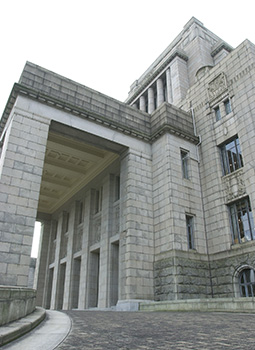INDEX
- English
- 日本語

The Diet Building viewed from the front - English
- 日本語

A mosaic in the Central Hall

The walls and pillars in the Central Hall feature stones from Okinawa such as Ryukyu stone (coral limestone) 
Central entrance of the National Diet Building
October 2021
Japan’s Stone Architecture, Born of Modernization

The National Diet Building in Tokyo, completed in 1936, was constructed using a rich variety of stone sourced from around Japan as the country pursued modernization.

Following the fall of the Tokugawa shogunate in 1868, the newly established Meiji government set about modernizing the nation by introducing social systems and technologies from the countries of Europe and America. In 1881, after the announcement that the first Diet session would be held in 1890, the government embarked on a plan to construct the National Diet Building (hereinafter, “the Diet Building”). At the time, Japan did not yet have people with the necessary skills to design large Western-style buildings, so the government commissioned renowned German architects Hermann Ende and Wilhelm Böckmann to design the Diet Building. In 1887, the two men created a design proposal for a Neo-Baroque style* Diet Building with a brick framework and natural stone exterior walls, but the proposal was not realized owing to the time it would take to construct and budgetary constraints. Later, however, a succession of Western-style buildings appeared using brick and stone designed by Japanese architects who had studied Western architecture. These included the former Yokohama Specie Bank main branch building (now the Kanagawa Prefectural Museum of Cultural History, completed in 1904), Togu Gosho (Crown Prince’s Palace, now the “State Guest House, Akasaka Palace,” completed in 1909), and Tokyo Station (completed in 1914).
“In the second half of the nineteenth century in Europe, there was an increase in brick buildings constructed using stone in prominent places on their exteriors in order to add prestige. Buildings with walls made entirely of stone in particular were considered to be the most prestigious,” says Horiuchi Masaaki, visiting researcher at the Institute of Modern Culture, Showa Women's University. “Ende and Böckmann’s design proposal was never realized, but it became the starting point for the Diet Building that stands today.”

After various discussions, construction of the Diet Building began in 1920. Government policy stipulated that the Diet Building be constructed from materials sourced in Japan as far as possible. Prior to commencing construction, therefore, stones around Japan were investigated and selected for use based on their robustness, workability, and beauty.
In 1936, the Diet Building was finally completed, with three floors above ground and one floor below ground, and a high tower in the center flanked by two parliamentary houses. The basic structure of the building is steel-reinforced concrete, which constituted state-of-the-art technology at the time. The rest of the building, including interior and exterior walls, floors, and stairs, features the generous use of various types of natural stone.
“One of the technical officers in charge of the design of the Diet Building stated that it was important for the building’s external appearance to be ‘solemn and quietly modest.’ I believe that perfectly sums up the Diet Building, which combines the solemnity of Neo-Baroque architecture with the quiet modesty of twentieth century modernist architecture that exerts restraint over ornamental features,” says Horiuchi. “The technology and culture of building with stone developed as Japan modernized, and the Diet Building is one fruit of that.”

The outer walls of the Diet Building are made of granite**. The first floor is made of Tokuyama stone, a stone from Kurokamijima island in Yamaguchi Prefecture with a slightly grayish hue. The second and higher floors are made of Odachi stone (also known as giin [diet chamber] stone), a stone with a pale pink hue that comes from Kurahashijima island in Hiroshima Prefecture.
The interior features more than thirty types of marble. Particularly exquisite are the mosaic floors of the Central Hall and the Hall in front of the Emperor’s Room. The arabesque patterns are created from 1.6 million tiny pieces of marble in more than ten different colors (one million pieces in the Central Hall and 600,000 pieces in the Hall in front of the Emperor’s Room). The walls and pillars of the Central Hall are made of Ryukyu stone (coral limestone) from Okinawa, in which fossils of snails and other creatures can be found.
“If you look at the individual stones in the exterior walls, you’ll notice that even those sourced from the same region are a slightly different color. This creates an appealing subtle quality that can’t be achieved with today’s uniform industrial materials such as bricks or concrete,” says Horiuchi. “When I visited the Diet Building last year (2020), it was raining. The stones of the building wet with rain had a glossy appearance, different from usual. The way natural stones change their appearance depending on the weather may be said to be another aspect of their appeal.”
As a prominent Japanese building that fully exploits the characteristics of the nation’s stone, the Diet Building continues to work its charm.
* The Neo-Baroque style of architecture spread throughout Europe in the latter half of the nineteenth century and is characterized by ornate stone decorative features.
** Granite is a coarse-grained igneous rock composed mainly of minerals such as quartz and potassium feldspar.

